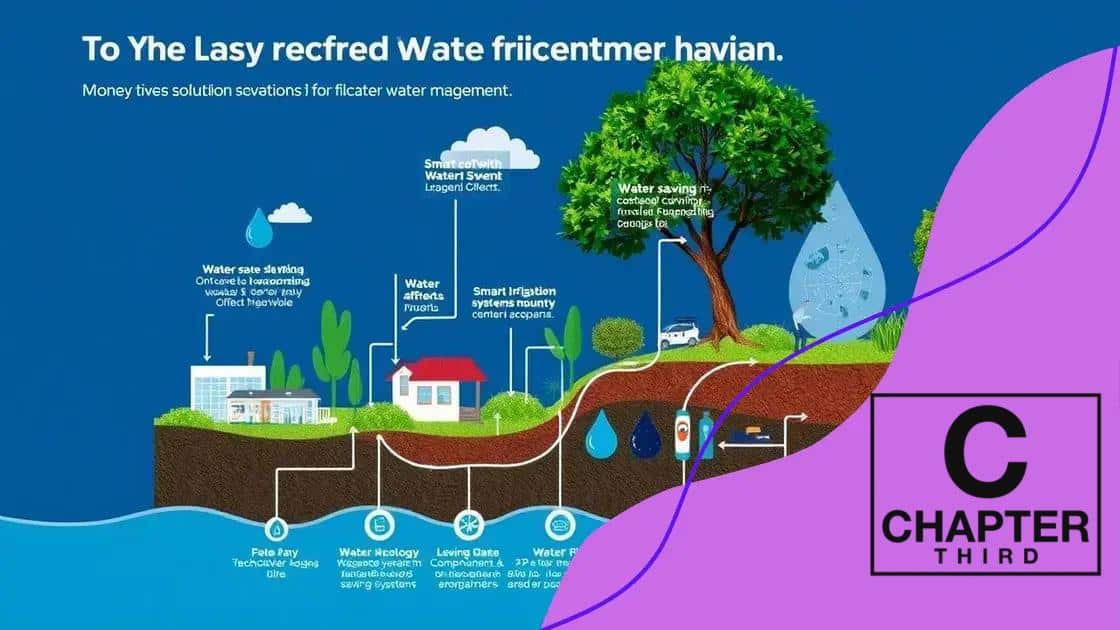Water scarcity drives new tech innovation

Water scarcity drives new tech innovation by promoting technologies like smart irrigation, rainwater harvesting, and desalination, while effective policies and collaboration enhance sustainable water management solutions.
Water scarcity drives new tech innovation as communities seek solutions to a pressing global challenge. Have you ever wondered how technology can address such an urgent need? Let’s explore the innovative strategies emerging in response to this critical issue.
Understanding water scarcity challenges
Understanding water scarcity challenges is crucial for finding effective solutions. Water is essential for life, and as populations grow, the demand for fresh water is increasing rapidly. Factors such as climate change, pollution, and over-extraction of resources are contributing to water scarcity across the globe. This issue affects not only individuals but also entire communities and economies.
Key Contributors to Water Scarcity
Several factors play a significant role in the challenges of water availability. Identifying these can help us address the problem effectively.
- Climate Change: Changes in weather patterns lead to unpredictable rainfall, droughts, and floods.
- Population Growth: More people mean greater demand for water in homes, agriculture, and industries.
- Pollution: Contaminated water sources reduce the amount of clean water available.
- Over-extraction: Excessive withdrawal of groundwater can deplete natural reserves.
Moreover, infrastructure challenges further complicate water distribution. Many regions lack the pipelines and treatment facilities necessary for providing safe drinking water. Without adequate systems in place, even areas with a sufficient water supply struggle to ensure its delivery. Public awareness and education are equally important in addressing these challenges, encouraging sustainable practices among individuals and businesses alike.
Impacts of Water Scarcity
The impacts of water scarcity extend beyond individual needs. When communities face limited water access, it can lead to food insecurity, health problems, and economic downturns. Farmers often struggle to irrigate crops, resulting in lower yields and increased prices for consumers. Additionally, inadequate water supplies can spread diseases, as people are forced to use contaminated sources.
Addressing water scarcity requires collective effort and innovative solutions. Understanding the specific challenges each region faces will help design appropriate interventions tailored to local needs. The journey towards sustainable water management is essential for ensuring future generations have adequate access to this precious resource.
Technological advancements in water conservation
Technological advancements in water conservation are changing the way we manage our water resources. With the rising concerns over water scarcity, modern innovations are becoming essential for sustainable management. Various innovative technologies are now available, making it easier to conserve water effectively.
Smart Irrigation Systems
One of the most significant advancements is the development of smart irrigation systems. These systems use sensors to monitor soil moisture and weather conditions. By analyzing data, they can determine the optimal amount of water needed for crops.
- Reduced Waste: Smart irrigation minimizes water waste by providing just the right amount.
- Increased Efficiency: Farmers can achieve higher crop yields with less water.
- Data-Driven Decisions: Continuous monitoring helps in making informed irrigation choices.
Additionally, rainwater harvesting has gained popularity as a means of conserving water. This technique collects and stores rainwater for various purposes, such as irrigation and household use. By capturing rainwater, communities can reduce their dependence on traditional water sources.
Desalination Technology
Another game-changer is desalination technology, which transforms saltwater into freshwater. This technology is particularly useful in coastal areas where freshwater is scarce. Although it requires significant energy and investment, it offers a viable alternative to meet water needs.
Moreover, innovative filtration methods, such as membrane technology, are improving water treatment processes. These advancements ensure that wastewater can be reused effectively, reducing the strain on natural water sources.
Public awareness and adoption of these technologies are critical for success. As individuals and businesses recognize the importance of conserving water, the implementation of these advanced systems will help protect our water resources for future generations.
Innovative solutions for efficient water management

Innovative solutions for efficient water management are essential in today’s world, where water scarcity is an increasing concern. New technologies and methods are being developed to help utilize our available water resources more wisely. By adopting these solutions, communities can help ensure sustainable access to clean water.
Water-Saving Technologies
One of the most impactful developments is the use of water-saving technologies, which reduce consumption while maintaining functionality. These solutions are vital in both urban and agricultural settings.
- Low-Flow Fixtures: Installing low-flow faucets and showerheads can significantly decrease household water use.
- Drip Irrigation: This efficient method delivers water directly to the roots of plants, minimizing waste.
- Smart Water Meters: These devices provide real-time data on water usage, helping consumers adjust their habits.
Moreover, water recycling systems are gaining traction in many communities. These systems treat and reuse wastewater for non-potable purposes, such as irrigation or industrial processes. By recycling water, we can alleviate pressure on freshwater sources.
Community-Based Approaches
Engaging communities in water management practices establishes a collective effort to conserve resources. Education plays a crucial role in this process. When individuals understand the importance of saving water and how to do it, they are more likely to take action.
Furthermore, local governments can support these efforts by implementing incentives for water-saving technologies. Programs that subsidize the installation of rain barrels or support xeriscaping (landscaping that reduces or eliminates the need for irrigation) can encourage residents to adopt efficient practices.
As we explore innovative solutions, it becomes clear that creativity and collaboration are key to overcoming water management challenges. Efficient use of water should be a priority for everyone to secure a sustainable future for our planet.
The role of policy in promoting tech innovation
The role of policy in promoting tech innovation is crucial, especially in addressing water scarcity. Policies can create an environment where new technologies thrive, helping communities effectively manage their water resources. Governments play a key role in setting regulations and providing incentives that encourage innovation.
Regulatory Frameworks
Having clear and supportive regulations is essential for tech innovations to flourish. When policies outline specific goals for water conservation and management, companies are more likely to invest in developing new solutions.
- Funding Opportunities: Governments can offer grants and subsidies to companies that focus on innovative water technologies.
- Research and Development: Support for R&D in water-saving technologies will drive advancements and make solutions more accessible.
- Standardized Practices: Clear guidelines for sustainable practices help streamline the implementation of new technologies.
Collaboration between sectors is another important aspect of policy. When government agencies work with private companies, non-profits, and community organizations, they can share knowledge and resources more effectively.
Incentives for Innovation
Incentives can motivate businesses to pursue innovative solutions. Tax credits or reduced fees for companies that invest in sustainable water use techniques encourage progress in this area.
Moreover, public awareness campaigns can promote the significance of technological advancements in water management. Educating consumers about how to use new tools and solutions helps create a more informed community that values innovation.
In conclusion, policies that support technological innovation are essential for addressing water challenges. By creating a favorable environment for businesses and fostering collaboration, we can pave the way for sustainable solutions that ensure everyone has access to clean water.
Case studies on successful tech applications
Case studies on successful tech applications provide valuable insights into how various innovations are addressing water scarcity. These examples illustrate the real-world impact of technology and can serve as models for other communities striving for sustainable water management.
Smart Irrigation in Agriculture
One prominent case study is the implementation of smart irrigation systems in California. Farmers adopted sensors that monitor soil moisture levels and weather conditions. This technology has allowed them to reduce water usage by up to 30% while increasing crop yields.
- Reduction of Waste: By using precise data, farmers apply only the necessary amount of water.
- Increased Crop Diversity: Better water management encourages farmers to grow more diverse crops.
- Cost Savings: Reduced water waste also leads to lower utility bills for farmers.
Another successful example comes from the city of Cape Town, South Africa, which faced severe water shortages. The city implemented a rainwater harvesting program, encouraging residents to collect rainwater for reuse. This initiative not only conserved water but also raised public awareness about the importance of saving this precious resource.
Desalination in Australia
Australia’s use of desalination plants is another important case study. During prolonged droughts, cities like Sydney invested in these facilities to convert seawater into drinking water. The desalination process has been instrumental in providing reliable water supplies during dry seasons.
These plants operate efficiently and help diversify water resources, ensuring communities have access to fresh water even in challenging conditions. The success of such projects highlights the importance of investing in innovative technologies to tackle water scarcity.
Learning from these case studies can inspire similar efforts in other regions facing water challenges. By studying effective applications of technology, communities can better understand how to implement successful solutions tailored to their specific needs.
FAQ – Frequently Asked Questions About Water Scarcity and Technology
What are some key technologies helping with water conservation?
Technologies like smart irrigation systems, rainwater harvesting, and desalination plants are crucial in addressing water scarcity.
How do case studies contribute to solving water challenges?
Case studies provide real-world examples and insights that can guide communities in implementing successful water management strategies.
Why is collaboration important in water management?
Collaboration between communities, governments, and businesses fosters innovation and ensures a collective effort towards sustainable water solutions.
How can policies promote technological innovation in water management?
Supportive policies can offer incentives, funding opportunities, and clear regulations that encourage the development and adoption of water-saving technologies.





